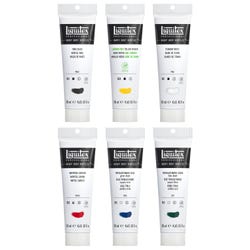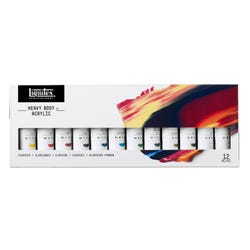Expressionistic Impasto Landscape

Description
Lesson Plan and Artwork by Jennifer Rolli
Impasto is a painting technique in which paint is applied thickly onto a canvas. The artist uses a stiff brush or palette knife to apply the paint to create texture, movement, shapes and shadows. Vincent Van Gogh was a master at this technique. Expressionistic painters admired Van Gogh’s use of this technique and quickly adopted it into their movement. In this lesson students will use an acrylic paint and gel gloss medium to create a landscape using the impasto technique.
Objectives
- Study the works of Vincent Van Gogh and the Expressionist painters to understand how they used the Impasto painting techniques to convey movement and meaning.
- Create a landscape using the impasto technique on a toned canvas. A toned canvas creates a neutral foundation and adds a unifying element.
- Explore how brush strokes can create movement.
Supplies Needed
Liquitex Heavy Body Classic Assortment, 12 color set
Liquitex Heavy Body Acrylic Large Tube Set, 6 color set
Liquitex Heavy Body - Burnt Sienna
Liquitex Gloss Gel Medium
Liquitex Basics Value Brush Set, 5 count
Sax Quality Stretch Canvas, 9x12
*Here are the supplies needed for this lesson plan for reference. Find a convenient carousel of shoppable products for this lesson below.
Standards
Standard#1: Generate and conceptualize artistic ideas and work.
Standard #2: Organize and develop artistic ideas and work
Standard #3: Refine and complete artistic work.
Standard #5: Develop and refine artistic work for presentation.
Standard #9: Apply criteria to evaluate artistic work.
Instructions
1
On a 9 x 12 inch stretched canvas prime with mixture of Burnt Sienna, Burnt Umber and Raw Sienna paint thinned with water to a sour cream consistency. Let dry for 5 minutes, then rub with cotton cloth, like a t-shirt, to expose the canvas tooth. Let dry completely.
2
In pencil, sketch landscape onto toned canvas, blocking in areas of light and dark. Squinting at the image will help with visualizing definitive blocks of color.
3
Prepare your palette with heavy body acrylic paints. Instead of mixing paints with traditional water, use gel medium to create a 3D brush stroke effect (like Van Gogh). This style of painting is referred to as Impasto. This 3-D effect adds an expressionistic energy with directional grooves created by the brush, directing the eye around the painting rapidly. These grooves play with light and shadow which need to be taken into consideration as they will effect the color being laid down.
4
Use a stiff bristle brush to apply paint. Scoop up thick mixed paint and brush into blocked area. You may want to add another color to that area to form highlights or shadows, swirling the colors to blend in desired areas of your painting. Try not to paint over pencil lines, the toned background will serve as your outlines pulling entire landscape together. See finished example.
5
Continue brushing in colors to blocked sections, keeping paint thick and showing brush stroke.
6
Be sure to step back from painting from time to time and adjust light and dark to your liking.
7
When the painting is finished, let dry completely. Erase pencil lines or remove with damp cloth.





